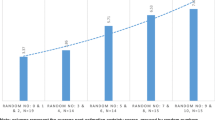Abstract
Experimental data comparing hypothetical and real dichotomous choice responses for two different goods were used to estimate a statistical bias function to calibrate the hypothetical yes responses. The probability that a hypothetical yes response would be a real yes response was estimated as a function of the individual's self-assessed certainty of the hypothetical yes response (assessed on a 0–10 scale) and a variable representing the price level. Without calibration the hypothetical yes responses significantly exceeded the proportion of real yes responses, but after calibration the null hypothesis of no difference between hypothetical and real responses could not be rejected in any of the experiments.
Similar content being viewed by others
References
Blackburn, McKinley, Glenn W. Harrison, and Elisabet E. Rutstrom. (1994). ''Statistical Bias Functions and Informative Hypothetical Surveys,'' American Journal of Agricultural Economics 76, 1084–1088.
Blumenschein, Karen, Magnus Johannesson, Glenn C. Blomquist, Bengt Liljas, and Richard M. O'Conor. (1998). ''Experimental Results on Expressed Certainty and Hypothetical Bias in Contingent Valuation,'' Southern Economic Journal 65, 169–177.
Bishop, Richard C., and Thomas A. Heberlein. (1979). ''Measuring Values of Extramarket Goods: Are Indirect Measures Biased.?,'' American Journal of Agricultural Economics 61, 926–930.
Champ, Patricia A., Richard C. Bishop, Thomas C. Brown, and Daniel W. McCollum. (1997). ''Using Donation Mechanisms to Value Nonuse Benefits from Public Goods,'' Journal of En®ironmental Economics and Management 33, 151–162.
Cummings, Ronald G., Steven Elliott, Glenn W. Harrison, and James Murphy. (1997). ''Are Hypothetical Referenda Incentive Compatible?'' Journal of Political Economy 105, 609–621.
Cummings, Ronald G., Glenn W. Harrison, and Elisabet E. Rutstrom. (1995). ''Homegrown Values and ¨ Hypothetical Surveys: Is the Dichotomous Choice Approach Incentive-Compatible?,'' American Economic Rev iew 85, 260–266.
Diamond, Peter A., and Jerry A. Hausman. (1994). ''Contingent Valuation: Is Some Number Better than No Number?,'' Journal of Economic Perspectiv es 8, 45–64.
Greene, William H. (1993). Econometric Analysis, 2nd Ed. New York: Macmillan.
Hanemann, W. Michael. (1984). ''Welfare Evaluations in Contingent Valuation Experiments with Discrete Responses,'' American Journal of Agricultural Economics 66, 332–341.
Hanemann, W. Michael. (1994). ''Valuing the Environment Through Contingent Valuation,'' Journal of Economic Perspectiv es 8, 19–43.
Johannesson, Magnus. (1996). Theory and Methods of Economic Ev aluation in Health Care. Dordrecht: Kluwer Academic Publishers.
Johannesson, Magnus, Bengt Liljas, and Per-Olov Johansson. (1998). ''An Experimental Comparison of Dichotomous Choice Contingent Valuation Questions and Real Purchase Decisions,'' Applied Economics 30, 643–647.
Kagel, John H., and Alvin E. Roth (eds.). (1995). The Handbook of Experimental Economics. Princeton, New Jersey: Princeton University Press.
Kristrom, Bengt. (1990). ''A Non-Parametric Approach to the Estimation of Welfare Measures in ¨ Discrete Response Valuation Studies,'' Land Economics 66, 135–139.
Li, Chuan-Zhong, and Leif Mattson. (1995). ''Discrete Choice under Preference Uncertainty: An Improved Structural Model for Contingent Valuation,'' Journal of En®ironmental Economics and Management 28, 256–269.
Mitchell, Robert C., and Richard T. Carson. (1989). Using Surv eys to Value Public Goods: The Contingent Valuation Method. Washington D.C.: Resources for the Future.
Nape, Steven, Peter Frykblom, Glenn W. Harrison, and James C. Lesley. (1995). Hypothetical Bias and Willingness to Accept. Economics Working Paper B–95–09, College of Business Administration, University of South Carolina.
Newbold, Paul. (1991). Statistics for Business and Economics, Third edition. Englewood Cliffs, New Jersey: Prentice-Hall.
Thaler, Richard. (1987). ''The Psychology of Choice and the Assumptions of Economics.'' in Alvin E. Roth (ed.), Laboratory Experimentation in Economics: Six Points of View. Cambridge, Cambridge University Press.
Wallis, W. Allen, and Milton Friedman. (1942). ''The Empirical Derivation of Indifference Functions.''in O. Lange, F. McIntyre, and T. O. Yntema (eds.), Studies in Mathematical Economics and Econometrics in Memory of Henry Schultz. Chicago: University of Chicago Press.
Author information
Authors and Affiliations
Rights and permissions
About this article
Cite this article
Johannesson, M., Blomquist, G.C., Blumenschein, K. et al. Calibrating Hypothetical Willingness to Pay Responses. Journal of Risk and Uncertainty 18, 21–32 (1999). https://doi.org/10.1023/A:1007708326467
Issue Date:
DOI: https://doi.org/10.1023/A:1007708326467




